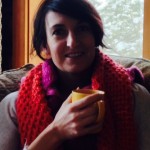All Lit Up
A review of Negative Spaces
by Sadie Hoagland
Nate Liederbach
elik press 2014
80 pages
$10
Negative space, visually, is the space in between and around the subject. Musically, it’s the silence between notes. The term seems ripe to apply to language, and bodies, too. However, I think whichever way you might approach the title of Nate Liederbach’s latest story collection, you will find that space filled in, and all possibilities of meaning exhausted by Liederbach’s strange and careful fiction. The three stories in this collection fill those negative spaces by exploring the in-betweens of animal-human, male-female, young-old, then-now, so that at the end of the second story, when the protagonist approaches a hole in a wall, he knows what it will reveal, and that “it will be everything,” and it really, magnificently, is.
The first two stories in this collection contain a certain hyperrealism that borders on magic. In “Genghis’ Knoll,” the protagonist introduces us to a sensibility that seems overwhelmingly practical juxtaposed against the surrealism of the scene. She is driving, both to and away, the isolated, coyote-ridden spot where she will shoot her dog-like boy, or perhaps it is a boy-like dog, with heartbreaking determination. As she does what she has to do, she wonders why she’s the one who fills negative spaces, and while she is thinking about oral sex with girls from her school, the reader understands that she’s filling that space in the story too, and that space for us as readers, when, as she is about to shoot Genghis, she asks, “Maybe pain and violence are just the opposite of death, some sort of exhaust, to throw us off?” She moves from outlining this negative space to inhabiting it, to becoming that which is in between, literally, life and death. This is a Herculean feat for a twenty-five page story.
The second and third stories are no less impressive. In “Across from the Fish Station,” two ski bums have returned to school and are taking a class in Virginity and Mythos, a class where they are the only male students. While one becomes a sort of court jester, making inflammatory comments and hooking up with classmates, the other feels he needs the course, that it is somehow keeping him afloat. But it is as if the weight of their fantasies about female sexuality, coupled with their professor’s ideas on how to “extricate the physical hymen from the exhausted conceptual variety” and the violence of an internet video of a woman being stoned to death, all implode to reach an ending, that really is, as stated, above “everything.”
A different kind of totality emerges in “The Long Tunnel,” where two boys finally dare to journey through a storm drain, and they emerge, but in between we hear about their relationship when they are older, the narrator’s first marriage, his second wife, his father and grandfather, an obsession with Amy Grant, and it seems again that no stone has been left unturned, that every possibility for this story has been dragged onto the page for us to see. As when the boys are in the storm drain, briefly afraid of a noise overhead, and the friend asks the narrator “What’d you think it was?” He replies, “nothing,” but wonders:
Nothing…Nothing but a resurfacing memory. Sure, but in its
nothingness, something? How, in attempting to abolish thought, it’s
hooking the poor kid. It’s reeling him. Folding everything of back then
into right now. How memory devours the present, and listen, this is a true story. I want you to know that. My integrity insists. It was written when I
was a boy, yes, but revised with sincerity now that I’m a man.
Nothing, then, is left in the dark in Liederbach’s collection, one best read slowly, a story-a-day kind of thing, letting each one soak into all your own spaces.
